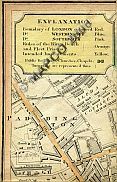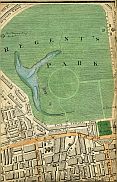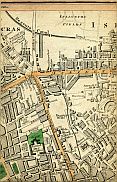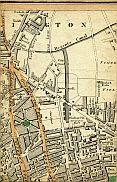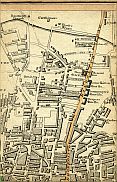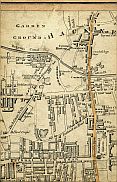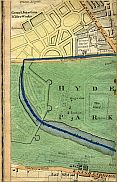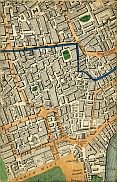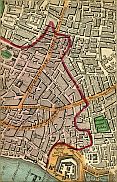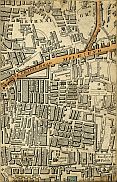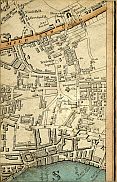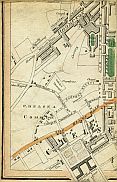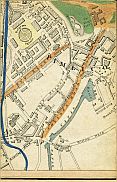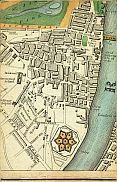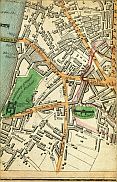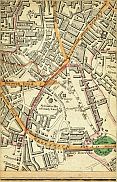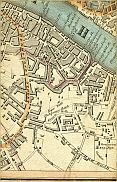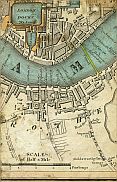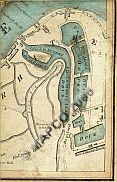Smith's New Map Of London c1830
Click Here To View The Map Image Without Borders
The Map
| Full Title: |
Smith's New Map Of London |
|
| Publisher: |
Charles Smith, 172 Strand. |
| Date: |
c1830 |
| Size: |
61cm x 34.5cm (24" x 13½") |
| Scale: |
3½" : 1 statute mile |
| Extent: |
Islington - Limehouse - Newington Butts - Hyde Park. |
| Description: |
Folding plan, with hard cover. Hand coloured sections laid down on linen. Title on cover only. Explanation top left. Compass rose top right. Scale bottom right. Boundaries etc. coloured to accord with the explanation. New and Old London Bridge shown, also St Katharine's Dock (opened 1828). New London Bridge shown as an "Intended Improvement" (it opened in 1831).
Howgego No. 328 (1)
|
This is the first known edition of Smith's map entitled 'New Map Of London,' and as such it is difficult to date accurately. This copy shows the positions of both Old London Bridge and the proposed New London Bridge, as well as the new St. Katharine's Dock. Construction of New London Bridge commenced in 1824, with the bridge opening on 1 August 1831. Work on St. Katharine's Dock commenced
in May of 1827 and it opened on 25 October 1828, clearly dating this map somewhere between October 1828 and August 1831.
The Explanation on the map shows the following colour key:
Boundary of London coloured Red
Boundary of Westminster coloured Blue
Boundary of Southwark coloured Pink
Rules of the Kings Bench and Fleet Prisons coloured Orange
Intended Improvements coloured Yellow
|
 |
The King's Bench and Fleet Prisons were both privately run debtors prisons. Debtors prisons were not populated by the criminal class, but rather by the higher classes, often reputable men and women of business and means, who had fallen on hard times and had debts called in by their creditors. In lieu of immediate payment, debtors were placed in prison until they could raise the money
to clear their debts, usually achieved by the sale of the debtors' assets. In addition to being imprisoned until their debts could be cleared, debtors were also required to pay for their time in prison, further adding to their financial hardships.
The Rules of King's Bench and Fleet Prisons were areas outside of the prisons' gates where prisoners of some means were permitted to wander or reside.
Shepherd's 'London' records the following about the King's Bench Prison, St. George's Fields:
"At the south-west corner of Blackman Street, in the road to the Obelisk, St. George's Fields, is situated the King's Bench Prison, for debtors, and every one sentenced by the Court of King's Bench; but those who can purchase the liberties have the benefit of walking through Blackman Street, a part of the Borough, and in St. George's Fields. This building is surrounded by a very
high wall. Prisoners in any other jail may remove hither by Habeas Corpus. This prison contains at least 300 rooms: the number of people confined here is greater; and decent accommodations are much more expensive than in the Fleet."
Regarding the Rules of the Fleet Prison, Farringdon Street, Shepherd's 'London' records:
"The circumference of the rules is about three-fourths of a mile. Prisoners are entitled to this on giving sufficient security to the warden. There are day rules in Term times, every day the Court sits. The ordinary expense of a day's rule to a prisoner is two pounds seven shillings for the whole, if the charge [debt] be under £500; in addition to this, four shillings
and sixpence are paid for each day. Several prisoners live most luxuriously within the walls, as well as in the rules, and this they all seem inclined to do, as far as their means will admit."
I hope that you enjoy looking at this fascinating aspect of London's social history.
How To Use These Map Pages
Use the thumbnail map at the top of each page to navigate your way around the map.
Hovering your mouse pointer over the thumbnails will highlight the individual sections, and display a pop-up message showing the area covered by that section of the map. Click the desired area to jump to a page displaying a full size image of the map section. You will need to scroll down the page a little to see the image of the map.
A coloured thumbnail image on the thumbnail map at the top of the page will show you which section of the entire map you are currently viewing.
Click To Enlarge
Once you are viewing the desired map section, you can click on the map image to view an enlarged image of that section.
Clicking on the map images allows you to switch back and forth ('toggle') between the normal sized image and the enlarged view of the section.
|



